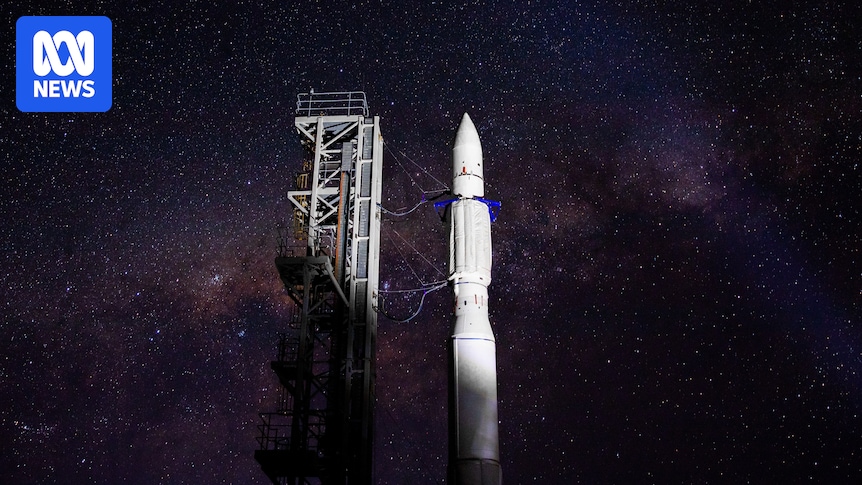An Australian-designed and manufactured rocket has been launched from home soil for the first time, crashing shortly after the historic moment.
The Gilmour Space orbital rocket, called Eris, was launched from a spaceport in the north Queensland community of Bowen on Wednesday morning.
The Gold Coast company tried to launch several times this year but was hampered by weather and technical issues.
Co-founder Adam Gilmour previously said that if the rocket was able to lift off the pad, he would deem the mission a success.
He said the rocket underwent extensive checks before any potential launch.
The Eris 1 rocket stands at its launch pad during preliminary testing in April last year. (Supplied: Gilmour Space Technologies)
“We just seem to find a bug every time we do a test. We did find a couple yesterday and the day before, but quick fixes,” he said.
The small town just north of Mackay is lovingly called “Blowin’ Bowen” by residents due to its notoriously windy conditions.
North and north-easterly winds were expected between 15 and 20 kilometres per hour on Wednesday, while maritime restrictions were in place alongside an airspace exclusion zone.
‘Part of history’
For Mackay resident Andrew Hyland, this was his third trip to Bowen to witness the rocket take-off.
“I’ve been up here since the first launch was programmed to go,” he said.
Andrew Hyland says he wants to see history made. (ABC North Qld: Baz Ruddick)
“Being Australia’s first launch in 50 years and first Australian-made … it’s part of history, you can’t miss out on history.”
Bowen residents Helen and Douglas Tawse were ready to watch the rocket take off from the beach.
Ms Tawse said the launch would “put Bowen on the map”.
Helen and Douglas Tawse waited for the launch at the beach. (ABC North Qld: Baz Ruddick)
Mr Tawse said the launch could generate benefits for the small north Queensland community.
“I never thought I’d ever see the day,” Mr Tawse said.
“If they’re talking about more satellites going up, it would have to help Bowen’s economy in the long term.”
‘Burgeoning commercial’ industry
Gilmour Space Technologies has received Australian Government support for its Bowen project, including $5 million for the Eris launch vehicle announced last week.
University of Southern Queensland astrobiologist and astronomer, Jonti Horner, said the launch of the Eris rocket was exciting and showed a maturation of the space industry.
Professor Horner said that historically, only government-run space agencies had the capability to launch rockets.
“In the last decade or so, there has been very much an explosion in our use of space, and that’s been because there has been a shift to commercial capacity to put things into orbit,” he said.
Jonti Horner says it is important that Australian space companies build capability. (Supplied)
“As soon as it becomes a commercial enterprise, that means the technology is now much more mature and the prices drop hugely, and there is now this burgeoning global industry of commercial spaceflight and the commercial use of space.”
Dr Horner said forecasting the weather for a launch could be tricky due to the many layers of the atmosphere.
“Just because you have calm weather at ground level doesn’t mean the weather is going to be calm all the way up through the atmosphere and it doesn’t mean the wind will be blowing at the same direction in all levels,” he said.
He said launches required the weather to be as calm as possible.
“You want the conditions to be perfect because you want to learn about how the rocket behaves, not how the atmosphere behaves,” he said.
“The bulk of what they will deal with is in that first 10 kilometres, and if you have crosswinds or you have wind shear, they will just wait and go another day.”
Gilmour Space Technologies cut its May launch campaign short after staff reported two anomalies on different days.
The first was a power supply issue and the second was the premature opening of the spacecraft’s payload fairing, or nose cone.
Another nose cone was taken from the Gold Coast to Bowen and installed.
The company hopes to eventually send satellites into orbit from Australia for commercial entities and government.

